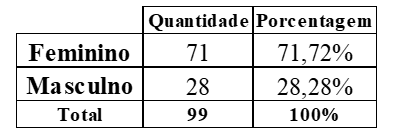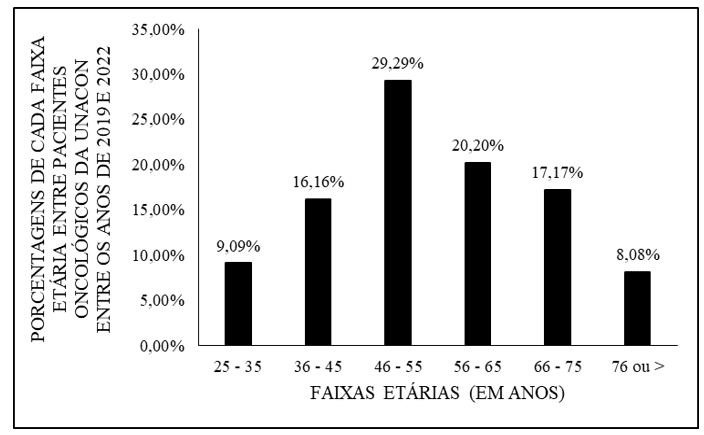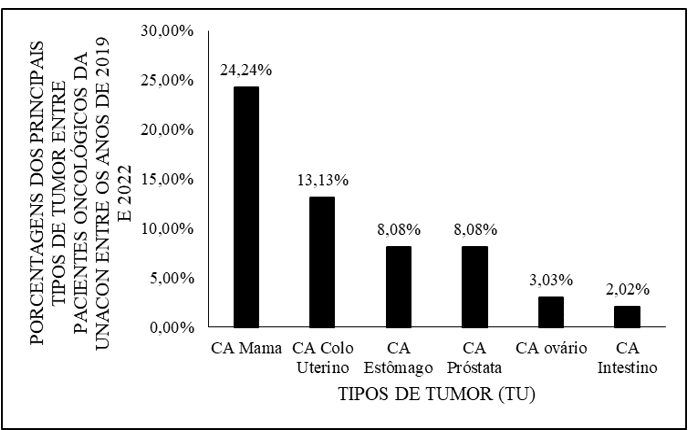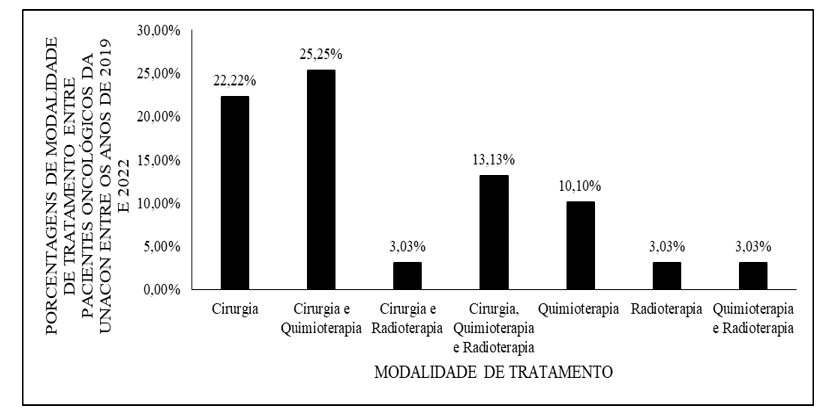ORIGINAL ARTICLE
CASTRO, Ellen Paola de Araújo [1], REBOUÇAS, Ingrid Araújo [2], RODRIGUES, Raíza Júlia Viana [3], LUCENA, Larissa Sena de [4], RODRIGUES, Ana Caroline Santana [5], SANTOS, Helen Derlane Rabelo [6], LOBATO, Renan Gustavo Mota [7], ALVES, Roberto Marcel Soares [8], DIAS, Claudio Alberto Gellis de Mattos [9], DENDASCK, Carla Viana [10], FECURY, Amanda Alves [11]
DENDASCK, Carla Viana. et al. Oncologic Disease in Patients at the High Complexity Oncology Unit (UNACON) of Amapá, Amazon, Brazil, between 2019 and 2022. Revista Científica Multidisciplinar Núcleo do Conhecimento. Year 07, Ed. 11, Vol. 02, pp. 207-217. November 2022. ISSN: 2448-0959, Access link: https://www.nucleodoconhecimento.com.br/health/complexity-oncology, DOI: 10.32749/nucleodoconhecimento.com.br/health/complexity-oncology
ABSTRACT
Cancer is a chronic disease of significant and growing magnitude. This serious public health problem accounts for approximately 30% of all premature deaths from Non-Communicable Chronic Diseases (NCDs). This study aimed to quantify oncological disease in patients at the Unidade de Alta Complexidade de Oncologia do Amapá (UNACON) between 2019 and 2022. It was an exploratory-descriptive study with quantitative analysis. A higher frequency of cancer was observed in females aged 46 to 55 years, with breast neoplasia being the most commonly identified type, and the primary treatments used were surgery and chemotherapy. Therefore, there is a need to focus on preventive and health promotion measures in primary care, as well as attention to the high-complexity unit in the state for structural improvements that can provide convenience, comfort, and a minimum level of privacy for patient and caregiver research.
Keywords: Cancer, UNACON, Amapá.
INTRODUCTION
Cancer is a chronic disease of significant and increasing magnitude. This serious public health issue accounts for approximately 30% of all premature deaths from Non-Communicable Chronic Diseases (NCDs) in the adult age range of 30 to 69 years (WHO, 2020). Nationally, it is estimated that in each component of the triennium from 2020 to 2022, there will be 625,000 new cancer cases, including non-melanoma skin cancer. Among these, the most common are skin cancer with 177,000 cases, followed by breast and prostate cancers with 66,000 each, colorectal cancer with 41,000 cases, lung cancer with 30,000 cases, and stomach cancer with 21,000 cases. When considering age-adjusted incidence rates and excluding non-melanoma skin cancer, there is a predominance of male cases with 215.86 cases per 100,000, while in females, it is expected to be 145 cases per 100,000 (INCA, 2019).
Regarding the causes of cancer, it is observed that malignant tumors have a multifactorial etiology, including environmental factors, genetic predisposition (LEWANDOWSKA et al., 2019), sources of radiation, genetic alterations such as tumor suppressor gene inactivation or the activation of certain proto-oncogenes, chemical substances, infectious agents, with a focus on Human Papillomavirus (HPV), the Human Immunodeficiency Virus (HIV), among others (MAHMOOD and SRIVASTAVA, 2022). Other modifiable habits also influence etiopathogenesis, such as smoking, poor dietary habits, physical inactivity, excessive alcohol consumption (BRASIL, 2021), and reproductive behavior (LEWANDOWSKA et al., 2020).
Concerning cancer treatment, it is important to note that each type of cancer has its unique disease history, requiring different lines of care. In summary, treatment can be carried out through surgery, chemotherapy, radiation therapy, or bone marrow transplantation, either in isolation or in combination. Treatment goals include cure, extending life, and improving the quality of life. In general, the earlier the disease is detected and treated, the greater the chances of a curative treatment (INCA, 2018).
When considering where to receive cancer treatment in Brazil, all states have at least one hospital qualified to treat cancer patients under the Brazilian Unified Health System (SUS). The expanded SUS network currently includes 317 units and centers qualified for cancer treatment. These units and centers fall under the National Policy for Cancer Prevention and Control, which stipulates that cancer treatment should be provided in healthcare facilities qualified as Unidade de Alta Complexidade de Oncologia (UNACON) or Centro de Assistência de Alta Complexidade em Oncologia (CACON). The entry point into the public healthcare system is through the Primary Care Network, responsible for referring patients to specialized services (INCA, 2022).
In Amapá, Macapá is home to Dr. Alberto Lima Clinical Hospital, which has its UNACON (INCA, 2022a). This unit is managed by the State Health Department (SESA) and offers outpatient, chemotherapy, and emergency care services (SESA, 2022). In addition, in partnership with the Government of the State of Amapá (GEA), there is the Hospital de Amor Prevention Institute, which supplements the public network in cancer treatment, providing free access to preventive exams. It has the capacity to perform 500 procedures per day for the detection of breast and cervical cancer, which are the most common in the state (HA, 2019).
Understanding the trends in the cancer epidemiological profile is necessary to assess and monitor healthcare services and the outcomes of screening strategies. Data collection allows for the identification of local needs and the development of specific national and regional public policies, as well as reducing public spending on disease treatment. However, Brazil still faces a significant challenge in having up-to-date and accurate cancer epidemiology records (GIRIANELLI et al., 2014; LOUREIRO et al., 2019; BARROS et al., 2020). Amapá, in particular, encounters this difficulty. Therefore, it is important to comprehend the clinical and epidemiological characteristics of patients treated at UNACON, Macapá-AP, between the periods of 2019 and 2022.
OBJECTIVE
Quantify oncological disease in patients at the Unidade de Alta Complexidade de Oncologia do Amapá (UNACON) between 2019 and 2022.
METHOD
This is an exploratory-descriptive study with quantitative analysis. Primary data were obtained through the administration of a sociodemographic questionnaire and a clinical-medical questionnaire with closed-ended questions regarding the time of diagnosis and type of tumor (BROADBENT et al., 2006).
The questionnaires were administered between 2019 and 2022 to 99 oncological patients, aged 18 and older, during their treatment at the Unidade de Alta Complexidade de Oncologia do Amapá (UNACON), following approval by the Ethics Committee (CEP) with CAAE registration number 16326319.1.0000.0003.
RESULTS
Figure 1 displays the quantities and percentages of oncological patients at UNACON, between 2019 and 2022, according to biological sex. Women represent the majority, with 71 patients (71.72%), while men account for 28 patients (28.28%).
Figure 1 shows the quantities and percentages of oncological patients at UNACON, by biological sex, between 2019 and 2022
The percentages of each age group among oncological patients at UNACON between the years 2019 and 2022 are shown in Figure 2. The primary age group is 46 to 55 years, with 29.29% of patients (29 individuals), followed by the age groups of 56 to 65 years – 20.20% (20 individuals), 66 to 75 years – 17.17% (17 individuals), 36 to 45 years – 16.16% (16 individuals), 25 to 35 years – 9.09% (09 individuals), and finally, a rate of 8.08% (08 individuals) for the age group of 76 years or more.
Figure 2 shows the age ranges, in percentage, of oncological patients at UNACON between the years 2019 and 2022
Different types of tumors (TU) can affect oncological patients. The main types were breast (24.24% – 24 individuals), cervical (13.13% – 13 individuals), stomach and prostate (8.08% – 08 individuals each), ovarian (3.03% – 03 individuals), and intestinal (2.02% – 02 individuals) (Figure 3).
Figure 3 displays the percentages of the main types of tumors among oncological patients at UNACON between the years 2019 and 2022
The main treatment modalities are shown in Figure 4. Among the patients, 22.22% (22 individuals) underwent surgery, 25.25% (25 individuals) underwent surgery and chemotherapy, 13.13% (13 individuals) underwent surgery, chemotherapy, and radiation therapy, 10.10% (10 individuals) received chemotherapy, and surgery and radiation therapy, radiation therapy alone, chemotherapy and radiation therapy 3.03% (03 individuals).
Figure 4 displays the treatment modality among oncological patients at UNACON between the years 2019 and 2022
DISCUSSION
Based on the results obtained, it was identified that women represent the majority of patients under the care of the state’s high-complexity unit, accounting for 71 patients (71.72%), while men represent 28 patients (28.28%). In light of this discrepancy, an association is made between men and self-care practices, thus demonstrating the existence of social beliefs that historically discourage men from seeking healthcare services for themselves, due to the perception of masculinity being associated with strength and a lower likelihood of falling ill (BOTTON et al., 2017). Consequently, men may find it challenging to consider themselves as subjects of care, as seeking health promotion and prevention services may be seen as a sign of weakness, aligning them with a more feminine image (GUTMANN et al., 2022).
These data reveal the lower utilization of healthcare services by men for various reasons, such as lack of time to seek such services and long waiting times, leading men to primarily access specialized care services. This, in turn, results in late diagnoses with a lower likelihood of resolution. Women, on the other hand, seek around 20% more medical appointments and are thus more present in medical offices and more likely to undergo treatments (IBGE, 2020).
However, there are studies indicating higher occurrence rates of most types of cancer in men compared to women. Differences in cancer risk were assessed for each of the 21 anatomical sites among 171,274 men and 122,826 women aged 50 to 71 who participated in a monitoring study from 1995 to 2011. During this period, 17,951 new cancers developed in men and 8,742 in women. Incidence was lower in men than in women only for thyroid and gallbladder cancers, with risks ranging from 1.3 to 10.8 times higher for men than for women at other anatomical sites. The results suggest that the higher prevalence of cancer in men is largely due to biological differences and, to a lesser extent, behavioral differences (e.g., smoking, alcohol use, or diet). Among the higher risk factors, it is believed that higher levels of testosterone may promote cell growth, leading to increased risks of melanoma, prostate, and liver cancers in men, as well as a higher risk of breast and endometrial cancer in women. Another factor is the stronger humoral immune responses (Th2) in women, which may reduce susceptibility to cancer, such as fighting infections from hepatitis B, C, and HPV, mediating a lower risk of liver and oropharyngeal cancer, respectively (JACKSON et al., 2022).
From the collected data, it was possible to observe that the most prevalent age group is 46 to 55 years, with 29.29% of patients (29 individuals), followed by individuals aged 56 to 65, accounting for 20.20% (20 people). Considering the age group above 60 years, there are 36 patients (35.6% of the sample). Given this scenario, it can be inferred that these patients are more exposed to socioeconomic conditions that trigger neoplastic pathogenesis, such as smoking, alcohol consumption, dietary habits, and obesity (ASSUNÇÃO and FRANÇA, 2020; MALTA et al., 2020).
These findings were consistent with the results of a quantitative, cross-sectional, exploratory, and descriptive study in five major municipalities in the southern health macro-region of the state of Minas Gerais, encompassing 54,206 appointments from 2008 to 2017, which showed a predominance of the age group between 60 and 79 years (49.95%) (PAIVA et al., 2020). Similarly, the findings were in line with a study conducted in a population residing in the state of Pará, between 2013 and 2020, which found that the most affected by breast cancer were women aged 45 to 54 years (30.20%) (NEVES et al., 2021). In contrast, a study involving 18,890 women receiving care at a specialized hospital in the capital of Rio de Janeiro observed that the highest prevalence of this pathological condition was in women aged 49 or younger (SANTOS et al., 2022).
The main types of tumors identified in the study were breast cancer, accounting for approximately 24%, and cervical cancer, with 13.13%. These data can possibly be explained by the fact that the female gender represented 71.12% of the participants in the study, carrying more weight. In contrast to the national context, where breast cancer incidence ranks first among women, excluding non-melanoma skin cancer, at 29.7%, and colon and rectal cancer comes second with 9.2%, while cervical cancer is third with 7.5%, in the state of Amapá, the most prevalent cancer, according to estimates for 2020, was cervical cancer with 22.31%, and breast cancer came second with 15.84% (INCA, 2019).
In recent years, there has been a decrease in the incidence and mortality of breast and cervical cancer in developed countries. However, countries in sub-Saharan Africa and Southeast Asia still maintain the highest rates of the latter disease (FERREIRA et al., 2021). Brazil has shown differences in the evolution of these indicators, with a decrease in mortality from cervical cancer and an increase in breast cancer; nevertheless, the Northern and Northeastern regions have not followed the national decline due to the inverse correlation between socioeconomic status and cervical cancer rates (GIRIANELLI et al., 2014).
The ideal treatment of cancer involves a multidisciplinary approach: both for local control, with the use of surgery and radiotherapy playing crucial roles, and for systemic control, with clinical oncology and its variety of oral and intravenous medications, including chemotherapy, as an example (BALCH, 2018). Therefore, due to the wide range of tumor and clinical situations in which patients with a particular type of cancer may find themselves and the availability of multiple therapeutic options for the same tumor situation, it is not possible to standardize treatment modalities, and the chosen therapy should be individualized (BRASIL, 2014).
Hence, among the treatment modalities to which the study patients were subjected, 25.5% of them underwent surgery and chemotherapy only; 22.22% underwent surgery only; 13.13% underwent surgery, chemotherapy, and radiotherapy; 10.10% underwent chemotherapy only; 3.03% underwent radiotherapy only, and 3.03% underwent chemotherapy and radiotherapy only. It is worth noting that the low number of patients who underwent radiotherapy was directly influenced by the unavailability of this modality in our state. According to the Brazilian Radiotherapy Society, the average patient’s commute from Amapá for complete treatment is 1,500 kilometers, significantly higher than the Brazilian average of 72 kilometers, posing a significant obstacle to the continuity of cancer treatment (FERRIGNO, 2014).
CONCLUSION
The lower self-care among men compared to women may be linked to the affirmation of masculinity, leading them to seek preventive healthcare services less often, resulting in delayed diagnoses, worsening the clinical course of diseases, and reduced chances of resolution.
The difference in the prevalence of cases between male and female genders may be related to biological and behavioral differences, such as alcohol consumption, tobacco use, dietary patterns, as well as testosterone levels and immune response profiles, in the case of specific types of cancer. The patient’s age may reflect a longer exposure to the indicated risk factors.
Although a decrease in cervical and breast cancer mortality has been observed in Brazil, the Northern and Northeastern regions did not follow this trend, possibly due to socioeconomic factors.
Due to the variety of presentations and manifestations, cancer treatment involves a multidisciplinary approach and the use of different techniques and approaches. Patient commutes from the state of Amapá for complete treatment are above the national average, remaining a challenging issue for the continuity of cancer treatment and a motivating factor for the improvement of services in the state.
There is a need for improvement in the structure of care for these patients, who are in situations of emotional and physical vulnerability, requiring a welcoming and comfortable environment while waiting for their appointments. Likewise, there is a need for dedicated research spaces within the unit, to ensure the privacy of these patients.
REFERENCES
ASSUNÇÃO, A. A.; FRANÇA, E. B. Years of life lost by CNCD attributed to occupational hazards in Brazil: GBD 2016 study. Revista de saúde pública, v. 54, n. 28, p. 1-12, 2020.
BALCH, C. What is a Surgical Oncologist? . Ann Surg Oncol, v. 25, n. 1, p. 7-9, 2018.
BARROS, L. D. O. et al. Mortalidade Por Câncer De Mama: Uma Análise Da Tendência No Ceará, Nordeste E Brasil De 2005 a 2015. Rev. Brasileira De Cancerologia v.66. n. 1, 2020. Rev. Brasileira De Cancerologia, v. 66, n. 1, p. 1-8, 2020.
BOTTON, A.; CÚNICO, S. D.; STREY, M. N. Diferenças de gênero no acesso aos serviços de saúde: problematizações necessárias Mudanças – Psicologia da Saúde, v. 25, n. 1, p. 67-72, 2017.
BRASIL. Protocolos Clínicos e Diretrizes Terapêuticas em Oncologia. Brasília DF, 2014. Disponível em: < https://bvsms.saude.gov.br/bvs/publicacoes/protocolos_clinicos_diretrizes_terapeuticas_oncologia.pdf >. Acesso em: 03 nov 2022.
______. Plano de Ações Estratégicas para o Enfrentamento das Doenças Crônicas e Agravos não Transmissíveis no Brasil 2021-2030. Brasília DF: Ministério da Saúde, 2021. 118 p.
BROADBENT, E. et al. The Brief Illness Perception Questionnaire. Journal of Psychosomatic Research, v. 30, p. 631 – 637, 2006.
CARNEIRO, V. S. M.; ADJUTO, R. N. P.; ALVES, K. A. P. Saúde do homem: identificação e análise dos fatores relacionados à procura, ou não, dos serviços de atenção primária. Arq. Cienc. Saúde UNIPAR, v. 23, n. 1, p. 35-40, 2019.
FERREIRA, M. D. C.; VALE, D. B.; BARROS, M. B. D. A. Incidência e mortalidade por câncer de mama e do colo do útero em um município brasileiro. Rev. Saúde Pública, v. 55, n. 67, p. 1-9, 2021.
FERRIGNO, R. Panorama da Radioterapia no Brasil. São Paulo SP, 2014. Disponível em: < http://www.oncoguia.org.br/pub/15_oncoguia_noticias/Panorama_Radioterapia_Brasil.pdf >. Acesso em: 03 nov 2022.
GIRIANELLI, V. R.; GAMARRA, C. J.; SILVA, G. A. E. Disparities in cervical and breast cancer mortality in Brazil. Rev. Saúde Publica, v. 48, n. 3, p. 459-467, 2014.
GUTMANN, V. L. R. et al. Motivos que levam mulheres e homens a buscar as unidades básicas de saúde. J. nurs. health. v.12, n. 2, 2022, v. 12, n. 2, p. 1-11, 2022.
HA. HA inaugura duas unidades de prevenção na região Norte do país. São Paulo SP, 2019. Disponível em: < https://hospitaldeamor.com.br/site/tag/hospital-de-amor-macapa/>. Acesso em: 07 set 2022.
IBGE. Pesquisa Nacional de Saúde – Atenção primária à saúde e informações antropométricas. Rio de Janeiro RJ: IBGE, 2020. 66p.
INCA. ABC do câncer: abordagens básicas para o controle do câncer. Rio de Janeiro RJ: Instituto Nacional de Câncer José Alencar Gomes da Silva, 2018. 111p.
______. Estimativa 2020: incidência de câncer no Brasil. Rio de Janeiro RJ: Instituto Nacional de Câncer José Alencar Gomes da Silva, 2019. 120p.
______. Onde tratar pelo SUS. Rio de Janeiro RJ, 2022. Disponível em: < https://www.gov.br/inca/pt-br/assuntos/cancer/tratamento/onde-tratar-pelo-sus >. Acesso em: 04 setembro 2022.
______. Onde tratar pelo SUS>Região norte. Rio de Janeiro RJ, 2022a. Disponível em: < https://www.gov.br/inca/pt-br/assuntos/cancer/tratamento/onde-tratar-pelo-sus >. Acesso em: 04 setembro 2022.
JACKSON, S. S. et al. Sex disparities in the incidence of 21 cancer types: Quantification of the contribution of risk factors. Cancer, v. 128, n. 19, p. 3531–3540, 2022.
LEWANDOWSKA, A. et al. Quality of Life of Cancer Patients Treated with Chemotherapy. Int J Environ Res Public Health., v. 17, n. 19, p. 1-16, 2020.
LEWANDOWSKA, A. M. et al. Environmental risk factors for cancer – Review Paper. Ann Agric Environ Med., v. 26, n. 1, p. 1-7, 2019.
LOUREIRO, D. D. C. et al. Perfil Epidemiológico dos Principais Tumores Sólidos em uma Unidade de Alta Complexidade em Oncologia no Estado da Amazônia Legal. Rev. bras. ciênc. saúde, v. 23, n. 3, p. 273-286, 2019.
MAHMOOD, A.; SRIVASTAVA, R. Etiology of cancer. In: JAIN, B. P. e PANDEY, S. (Ed.). Understanding Cancer: From Basics to Therapeutics. Cambridge MA: Academic Press, 2022.cap. 3, p.37-62.
MALTA, D. C. et al. Doenças Crônicas Não Transmissíveis na Revista Ciência & Saúde Coletiva: um estudo bibliométrico. Ciência & Saúde Coletiva, v. 25, n. 12, p. 4757-4769, 2020.
NEVES, I. S. D. et al. Estudo epidemiológico sobre as neoplasias malignas da mama no estado do Pará no período de 2013 a 2020. Research, Society and Development, v. 10, n. 7, p. 1-10, 2021.
PAIVA, E. M. D. C. et al. Perfil dos atendimentos oncológicos de uma macrorregião de saúde brasileira. Av Enferm., v. 38, n. 2, p. 149-158, 2020.
SANTOS, T. B. D. et al. Prevalência e fatores associados ao diagnóstico de câncer de mama em estágio avançado. Ciência & Saúde Coletiva, v. 27, n. 2, p. 471-482, 2022.
SESA. UNACON. Macapá AP, 2022. Disponível em: < https://saude.portal.ap.gov.br/conteudo/rede-de-atendimento/unacon >. Acesso em: 07 set 2022.
WHO. WHO report on cancer: setting priorities, investing wisely and providing care for all. World Health Organization. Geneva: World Health Organization, 2020. 149p.
[1] Medical student at the Federal University of Amapá (UNIFAP).
[2] Medical student at the Federal University of Amapá (UNIFAP).
[3] Medical student at the Federal University of Amapá (UNIFAP).
[4] Medical student at the Federal University of Amapá (UNIFAP).
[5] Medical student at the Federal University of Amapá (UNIFAP).
[6] Medical student at the Federal University of Amapá (UNIFAP).
[7] Medical student at the Federal University of Amapá (UNIFAP).
[8] Medical doctor, professor, and researcher at the Medical School of the Federal University of Amapá (UNIFAP).
[9] Biologist, Ph.D. in Behavior Theory and Research, Professor, and researcher at the Institute of Basic, Technical, and Technological Education of Amapá (IFAP), the Professional and Technological Education Postgraduate Program (PROFEPT IFAP), and the Biodiversity and Biotechnology Postgraduate Program of the BIONORTE Network (PPG-BIONORTE), Amapá campus.
[10] Ph.D. in Psychology and Clinical Psychoanalysis. Ph.D. candidate in Communication and Semiotics at the Pontifical Catholic University of São Paulo (PUC/SP). Master’s in Religious Studies from the Mackenzie Presbyterian University. Master’s in Clinical Psychoanalysis. Bachelor’s in Biological Sciences. Bachelor’s in Theology. With over 15 years of experience in Scientific Methodology (Research Method) in guiding the production of scientific work for Master’s and Ph.D. students. Specializes in Market Research and Health-related Research. ORCID: 0000-0003-2952-4337.
[11] Biomedical scientist, Ph.D. in Tropical Diseases, Professor, and researcher at the Medical School, Macapá Campus, Federal University of Amapá (UNIFAP), and in the Postgraduate Program in Health Sciences (PPGCS UNIFAP). She also serves as the Vice Provost for Research and Postgraduate Studies (PROPESPG) at the Federal University of Amapá (UNIFAP).
Submitted: November 2022.
Approved: November 2022.



















